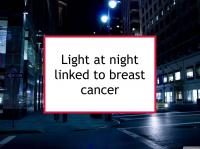Habitually sleeping in the presence of artificial light increases breast cancer risk by inhibiting melatonin production. Blue light wavelengths appear to have a far greater suppressive effect on melatonin production than red wavelengths. Now a new study has reported that outdoor artificial light entering the bedroom is associated with heightened breast cancer risk and that this depends on both the intensity and wavelength of the light.
Melatonin and breast cancer
Melatonin is a hormone that communicates information concerning environmental light conditions to various parts of the body and plays a vital role in the synchronization of circadian rhythms, daily 24-hour cycles that control most physiologic processes. Melatonin is synthesized and secreted by the pineal gland in the brain and is produced at night (or in conditions of darkness); nocturnal light suppresses melatonin synthesis.
While it is known primarily for its involvement in the regulation of circadian rhythms, melatonin has also been shown to have antioxidant, anti-inflammatory, and anti-carcinogenic properties, especially in breast cancer. Melatonin has been reported to reduce the viability of both hormone receptor positive (ER+/PR+) and triple negative (ER-/PR-/HER2-) breast cancer stem cells. Exposure to dim light at night (which suppresses melatonin synthesis despite being dim) has been shown to induce tamoxifen resistance in an animal model of ER+/PR+ breast cancer.
Latest research reports effects of light intensity and wavelength
The study referenced above was designed to evaluate the association of several measures of outdoor artificial light at night with risk of breast cancer. To conduct the study, the authors pooled data from two previous studies (baseline: 2009 to 2016, 24,793 female participants, 674 breast cancer cases).
Outdoor light at night exposures at residential addresses were estimated using images taken from the International Space Station. Outdoor light at night measures included brightness (average visual radiance), average melatonin suppression index (MSI, the extent to which the light suppresses melatonin), and the product of the two (average impact MSI). The analysis was adjusted for breast cancer risk factors and built environment features such as parks, streets, and buildings. In addition to breast cancer in general, the authors calculated associations according to certain breast cancer subtypes and among participants who reported that light entered their bedrooms during sleep.
No statistically significant associations were found for outdoor light at night measures and risk of breast cancer in the overall population. However, statistically significant associations of average impact MSI with breast cancer risk were observed among women reporting light entering their rooms during sleep (both overall and across each subtype). For example, participants in the highest tertile (third) of average impact MSI had over 1.5 times the breast cancer risk overall compared to those in the lowest tertile.
Note that melatonin suppression is dependent on both light intensity and wavelength. Wavelength determines the color of light. Red light, which has the longest wavelengths, has been shown to suppress melatonin production less than blue light, with its shorter wavelengths. However, satellites only measure light intensity and do not capture data concerning specific wavelengths.
The authors conclude that outdoor artificial light at night is associated with increased risk of breast cancer and that both the intensity and wavelength of light should be considered when evaluating artificial light at night exposures. The authors further comment that the wavelength of light may be a more important contributor to breast cancer risk than its intensity, based on the study findings.
The authors also point out that since LED bulbs tend to emit light in wavelengths that have been found to be more suppressive of melatonin secretion, the shift to LED bulbs for street lighting (as a more energy efficient option) might further increase breast cancer risk for some.
Please see our circadian rhythms and melatonin tags for more information.
